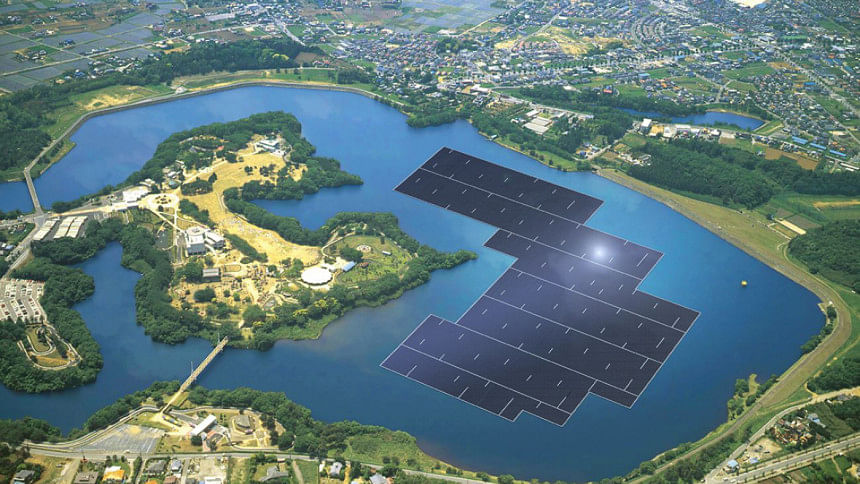Power of the sun

The sun is the source of almost unlimited energy. Given the sheer scale of the sun's energy, a point is often made in the energy literature that the sunlight striking the earth's surface in just one hour delivers enough energy to meet the global energy need for an entire year. But the more important point is how to convert solar energy into a controllable, useful form of energy such as electricity.
In the past, scientists were in the dark about how light can produce electricity. It was Albert Einstein who, for the first time, explained the photoelectric effect in one of his 1905 papers titled On a Heuristic Point of View Concerning the Production and Transformation of Light. Afterwards, in 1921, Einstein was awarded the Nobel Prize for his discovery of the law of photoelectric effect.
It would take half a century after Einstein's paper for the real breakthrough in putting the theory to practical use. In 1953, scientists at the Bell Labs unveiled the first photovoltaic (PV) cells, otherwise called solar cells, capable of producing useful amounts of power. Since then, solar PV technology attracted attention of researchers worldwide. Recently, scientists at the Bangladesh Council of Scientific and Industrial Research (BCSIR) have been successful in fabricating solar PV cells.
Since its inception, solar PV technology suffered mainly from two disadvantages: high cost and low efficiency. Research and technological development over time have brought about significant cost reductions of solar PV, but when it comes to efficiency, it is still below 20 percent in operative conditions. Due to low efficiency, it requires a huge area for useful power generation from ground-mounted solar PV.
The latest technological innovation that has minimised the burden of intense land requirement is Floating Solar PV. A floating solar PV system can conveniently be installed on still water bodies such as ponds, lakes, dams and reservoirs. Floating solar PV technology has a number of advantages over land-based equivalents. The foremost benefit is that it takes the advantage of idle water surfaces, and hence there is no direct competition with agriculture or other uses of land. Secondly, floating solar PV panels have higher power generation efficiency, which may be even more than 10 percent, as compared to the ones installed on land, owing to the cooling effect of water underneath the panels.
Thirdly, floating solar panels can shade the water they float on and reduce evaporation which is crucial for water conservation in dry season. Fourthly, floating solar PV is potentially less prone to shading and typically performs in a low-dust environment. Finally, operation and maintenance costs are also often reduced because the water needed for cleaning is available at source and components are less likely to overheat.
Considering its benefits, around a dozen countries worldwide have set up floating solar PV plants with capacities ranging from a few kilowatts (kW) to as high as 50 megawatts (MW). For example, Japan has installed a 13.7MW floating solar PV plant on a dam reservoir and China has installed a 40MW plant on a lake that formed following the collapse of a coal mine in the Anhui province. Three states of the neighbouring India—Madhya Pradesh, West Bengal, and Kerala—have installed floating solar PV plants with capacities of 1kW, 10kW and 50MW respectively.
Such systems are fast emerging as an alternative to conventional ground-mounted PV systems, which are land intensive. Deployment of floating solar PV in diverse countries at different scales signals the maturity of the technology to be replicated elsewhere with similar conditions.
Bangladesh possesses an enormous quantity of water bodies including rivers and streams, lakes and marshes, haors, baors, beels, reservoirs, ponds, and estuarine systems with extensive mangrove swamps. Many of them contain standing water throughout the year, making them suitable for installation of a floating solar PV system. Kaptai Lake, the lonely reservoir in the country with storage capacity, for example, appears to be a good site for setting up a floating solar PV system. The country's largest irrigation project, the Teesta barrage project, offers another suitable location for installation of a scalable floating solar PV system.
The abundance of water bodies dispersed throughout the country offers a wider scope and potential for installation of floating solar PV systems, provided the authorities concerned might find them out.
Bangladesh, a land-hungry country, simply cannot afford to keep her water bodies underutilised when there exists a potential to use them for solar electricity generation. Unexploited and non-revenue-generating water surfaces may be turned into commercial solar power plants taking advantage of the floating solar PV technology.
The authorities in charge of the management of water bodies may take initiatives to find out the ones suitable for solar power generation. They may either take steps to set up floating solar PV plants themselves, or let private-sector sponsors set up the same, and then they may sell the electricity to power utilities. A small initiative may launch a long journey to boost up solar electricity generation while ensuring better management of water bodies otherwise left unutilised.
Mohammad Alauddin is Joint Secretary, Power Division, the Ministry of Power, Energy & Mineral Resources, Bangladesh.
Email: [email protected]





Comments